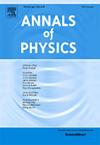Fractonic critical point proximate to a higher-order topological insulator: A Coupled wire approach
IF 3
3区 物理与天体物理
Q2 PHYSICS, MULTIDISCIPLINARY
引用次数: 0
Abstract
We propose an unconventional topological quantum phase transition between a higher-order topological insulator (HOTI) and a featureless Mott insulator, both sharing the same symmetry patterns. Our approach constructs an effective theory for the quantum critical point (QCP) by combining a bosonization technique with the coupled-stripe construction of 1D critical spin ladders. This phase transition is characterized by a critical dipole liquid theory with subsystem (1) symmetry, where the low-energy modes contain a Bose surface along the axis. This quantum critical point exhibits fracton dynamics and a breakdown of the area law for entanglement entropy, attributed to the presence of the Bose surface. We numerically validate our findings by measuring the entanglement entropy, topological rank-2 Berry phase, and static structure factor throughout the topological transition, comparing these results with our previous approach derived from the percolation picture. A significant new aspect of our phase transition theory is that the infrared (IR) effective theory is governed by short-wavelength fluctuations, demonstrating a unique UV-IR mixing.
求助全文
约1分钟内获得全文
求助全文
来源期刊

Annals of Physics
物理-物理:综合
CiteScore
5.30
自引率
3.30%
发文量
211
审稿时长
47 days
期刊介绍:
Annals of Physics presents original work in all areas of basic theoretic physics research. Ideas are developed and fully explored, and thorough treatment is given to first principles and ultimate applications. Annals of Physics emphasizes clarity and intelligibility in the articles it publishes, thus making them as accessible as possible. Readers familiar with recent developments in the field are provided with sufficient detail and background to follow the arguments and understand their significance.
The Editors of the journal cover all fields of theoretical physics. Articles published in the journal are typically longer than 20 pages.
 求助内容:
求助内容: 应助结果提醒方式:
应助结果提醒方式:


